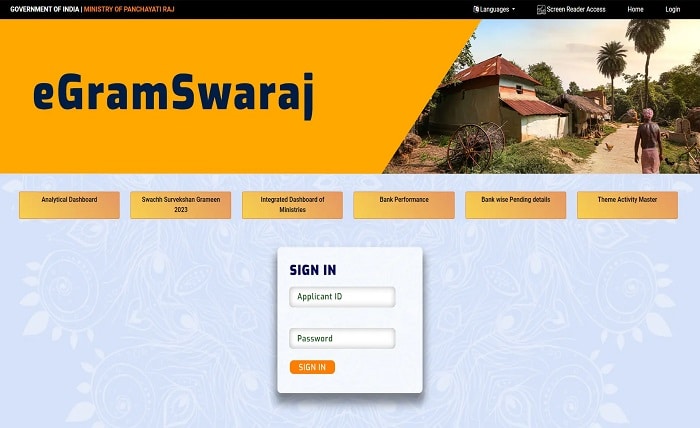In the heart of India’s rural landscape, a silent revolution is taking place. Panchayati Raj Institutions (PRIs), the grassroots bodies of democracy, are embracing digital technology to enhance their efficiency, transparency, and accountability. At the forefront of this transformation is eGramSwaraj, a comprehensive e-governance initiative launched by the Ministry of Panchayati Raj (MoPR) in 2014.
eGramSwaraj aims to bridge the digital divide between India’s urban and rural areas, empowering PRIs with the tools and resources they need to deliver effective governance at the village level. Through a suite of online modules and applications, eGramSwaraj facilitates the planning, budgeting, monitoring, and implementation of various development programs within PRIs.
Objectives of eGramSwaraj
The primary objectives of eGramSwaraj are:
- To enhance transparency and accountability in the functioning of PRIs
- To facilitate effective planning, budgeting, and implementation of development programs
- To improve service delivery to citizens
- To empower PRIs with the skills and knowledge necessary to navigate the digital world
Key Features of eGramSwaraj
eGramSwaraj offers a range of features that cater to the diverse needs of PRIs, including:
- Gram Panchayat Development Plan (GPDP): A tool for PRIs to formulate their annual development plans
- Integrated Financial Management System (IFMS): A system for managing financial transactions and records
- Work Based Accounting: A module for tracking and monitoring the progress of development works
- Online Payment Gateway: A platform for facilitating online payments of taxes and other dues
- Management Information System (MIS): A system for generating reports and statistics on various aspects of PRI functioning
Impact of eGramSwaraj
eGramSwaraj has had a significant impact on the functioning of PRIs, bringing about several positive changes, including:
- Increased transparency and accountability: eGramSwaraj has made the functioning of PRIs more transparent and accountable to citizens. Citizens can now access information about development plans, financial transactions, and work progress online.
- Improved planning and budgeting: eGramSwaraj has helped PRIs in making more informed and effective decisions regarding planning and budgeting. The GPDP module provides a framework for formulating comprehensive development plans, while the IFMS facilitates efficient financial management.
- Enhanced service delivery: eGramSwaraj has streamlined the process of service delivery, making it more efficient and accessible to citizens. Online payment gateways have facilitated the payment of taxes and other dues, while online grievance redressal mechanisms have provided citizens with a platform to register their complaints.
- Empowered PRIs: eGramSwaraj has empowered PRIs with the skills and knowledge necessary to navigate the digital world. Trainings and workshops have been conducted to familiarize PRI functionaries with the various modules and applications of eGramSwaraj.
Challenges and Future Directions
Despite its success, eGramSwaraj faces certain challenges, including:
- Digital literacy: Limited digital literacy among PRI functionaries and rural citizens can hinder the adoption and utilization of eGramSwaraj.
- Internet connectivity: Inadequate internet connectivity in rural areas can pose a challenge to accessing and using eGramSwaraj applications.
- Sustainability: Ensuring the sustainability of eGramSwaraj requires ongoing support from the government, including regular software updates, training, and technical assistance.
Moving forward, eGramSwaraj will focus on:
- Addressing digital literacy: Enhancing digital literacy among PRI functionaries and rural citizens through targeted training and awareness campaigns.
- Expanding internet connectivity: Collaborating with telecom service providers to expand internet connectivity in rural areas.
- Promoting sustainable adoption: Ensuring the long-term sustainability of eGramSwaraj through capacity building and institutional strengthening of PRIs.
Conclusion
eGramSwaraj is a transformative initiative that is empowering Panchayati Raj Institutions to deliver effective governance at the village level. By enhancing transparency, accountability, and efficiency, eGramSwaraj is contributing to the overall development of rural India. As eGramSwaraj continues to evolve, it has the potential to revolutionize the way PRIs function, bringing about a new era of inclusive and sustainable development in rural India.
Frequently Asked Questions (FAQs)
Q: What is eGramSwaraj?
A: eGramSwaraj is a comprehensive e-governance initiative launched by the Ministry of Panchayati Raj (MoPR) in 2014 to empower Panchayati Raj Institutions (PRIs) with digital solutions for effective planning, budgeting, monitoring, and implementation of development programs.
Q: What are the objectives of eGramSwaraj?
A: The primary objectives of eGramSwaraj are to enhance transparency and accountability in PRI functioning, facilitate effective planning and budgeting, improve service delivery to citizens, and empower PRIs.

